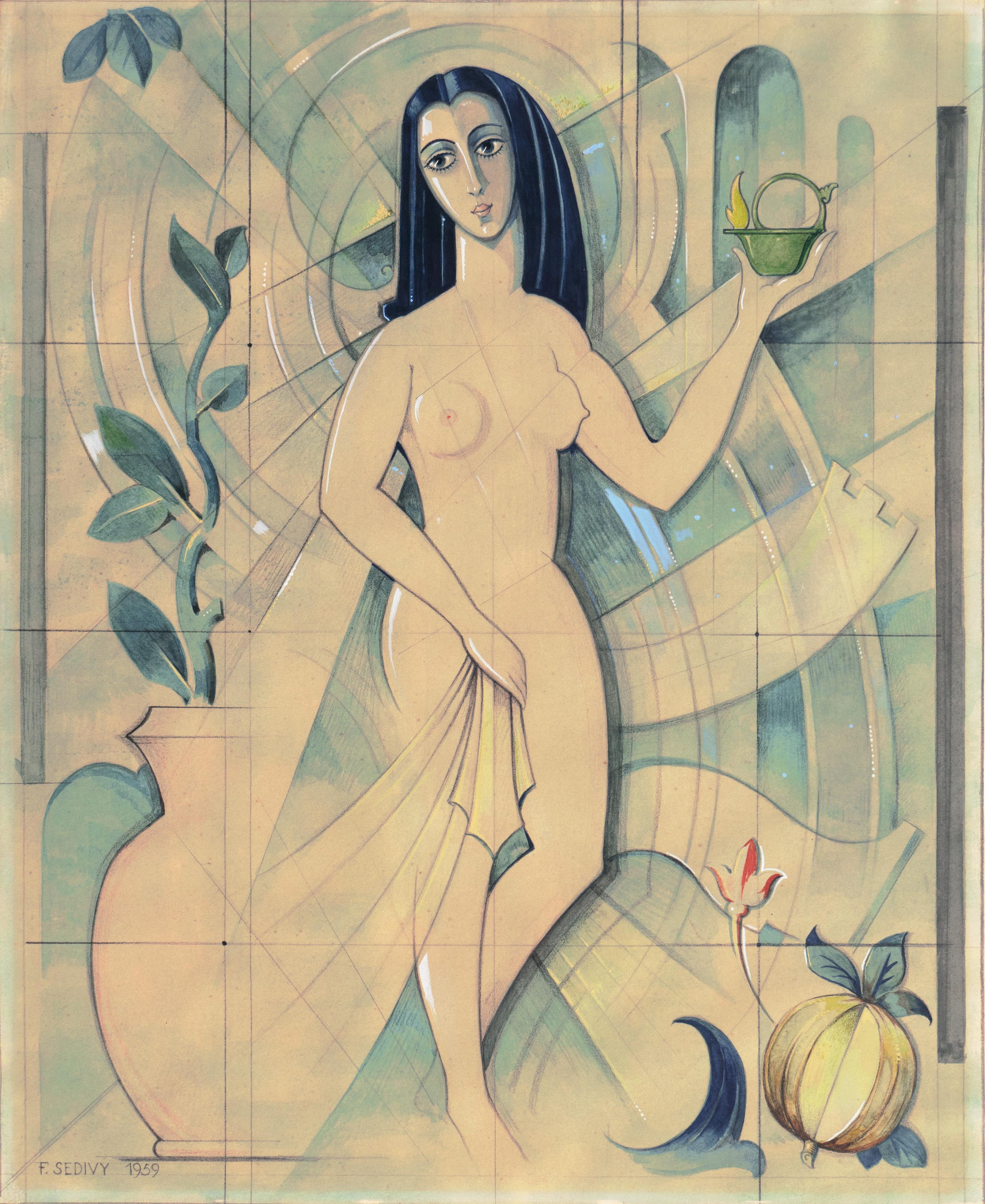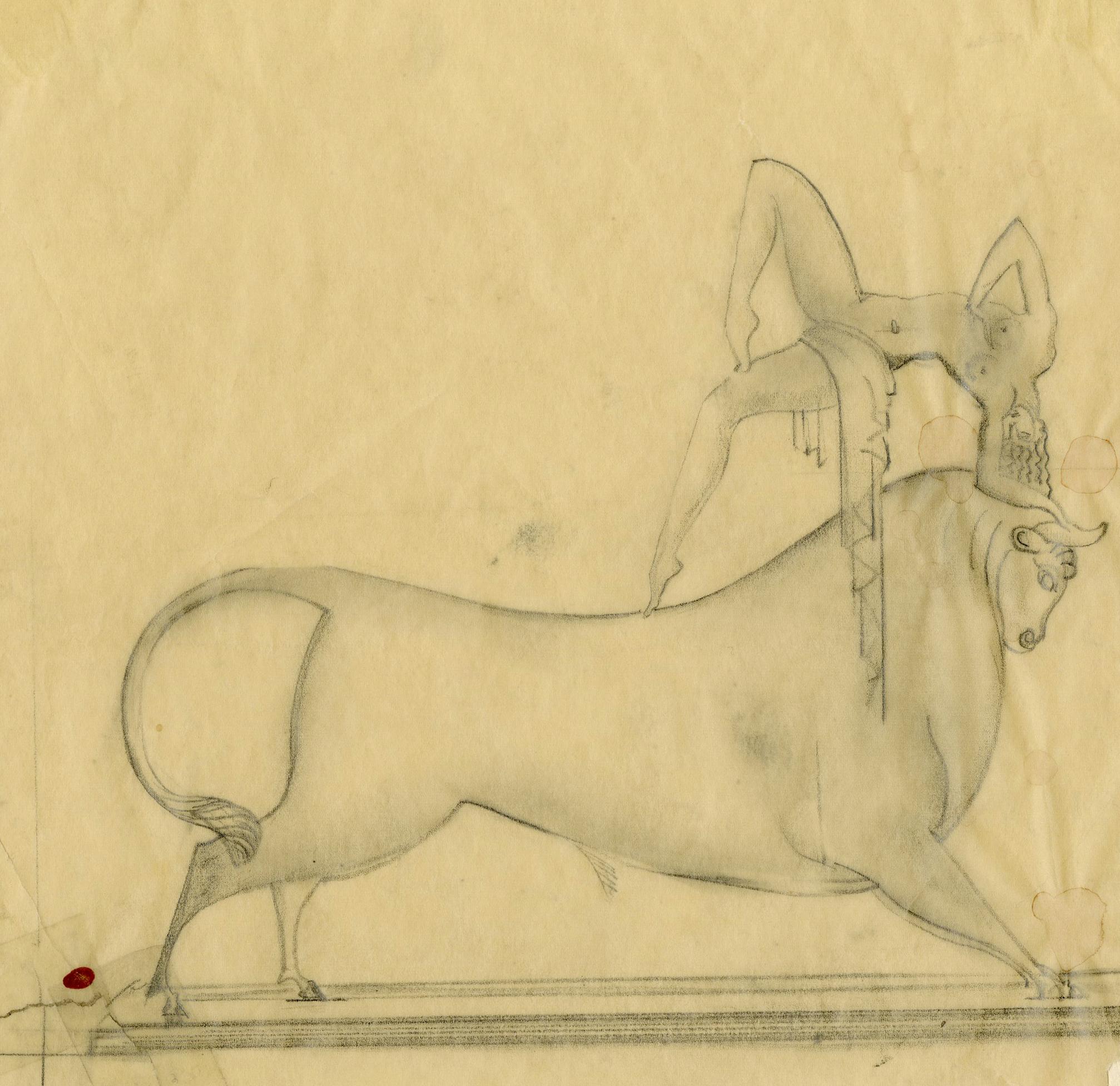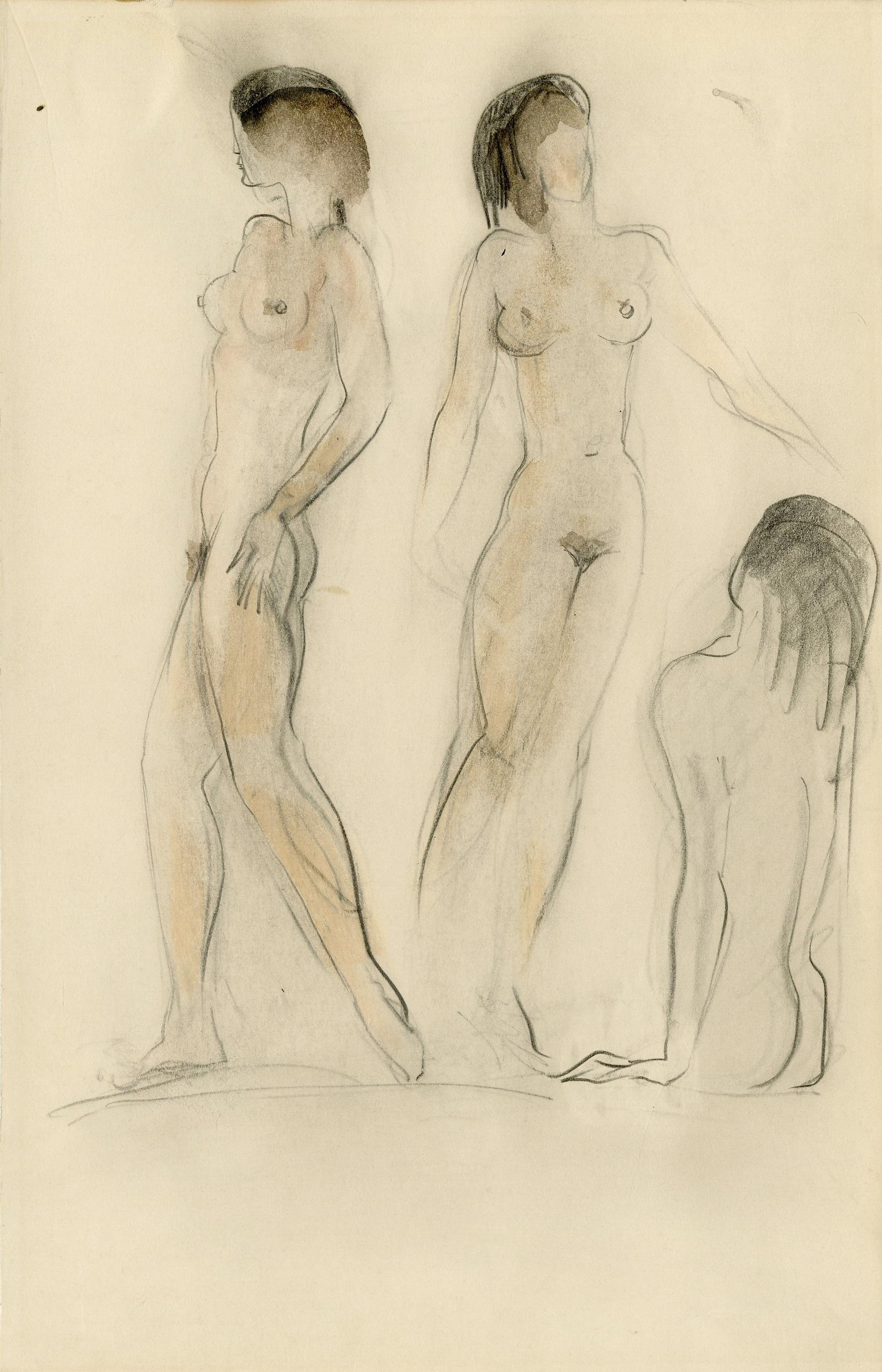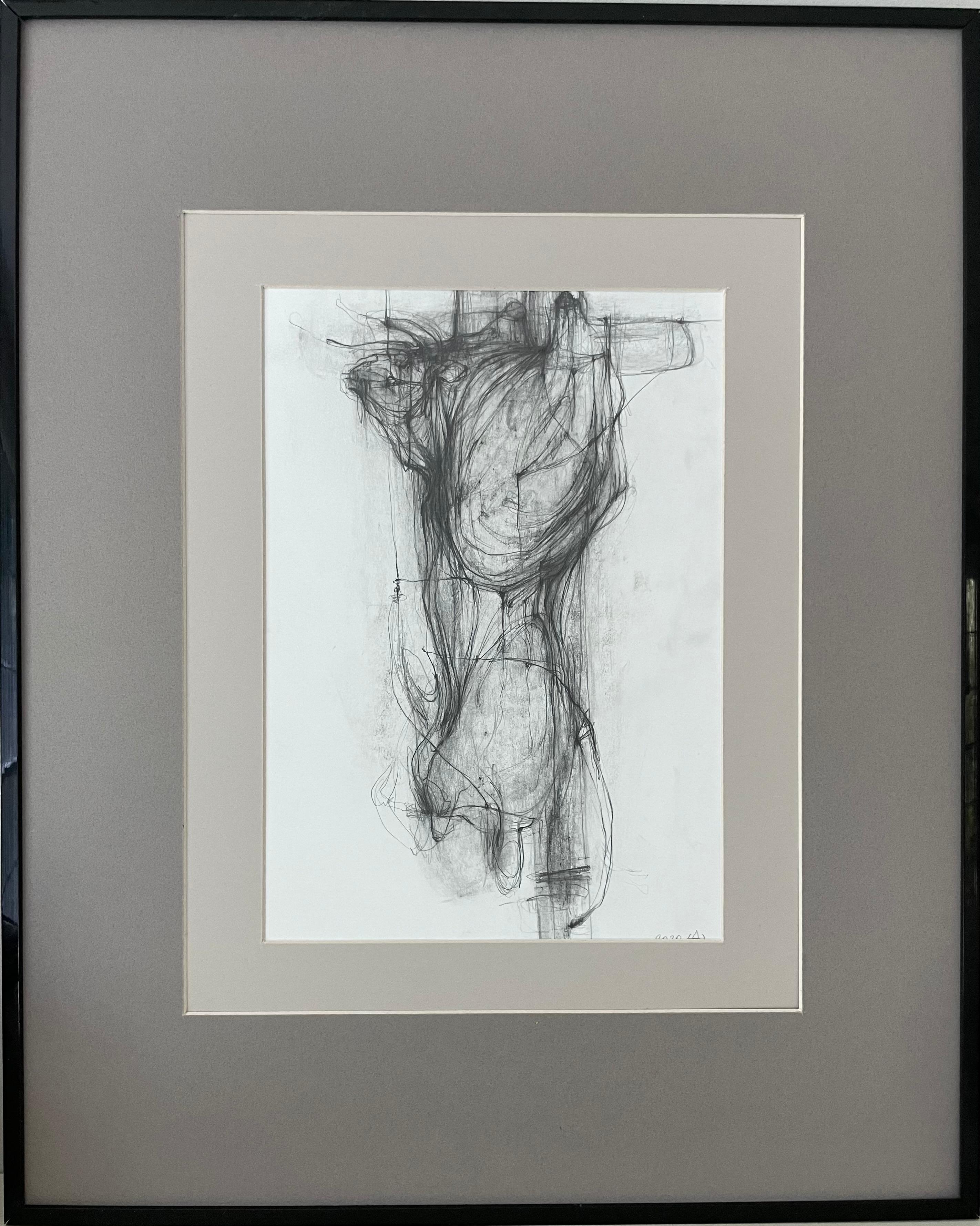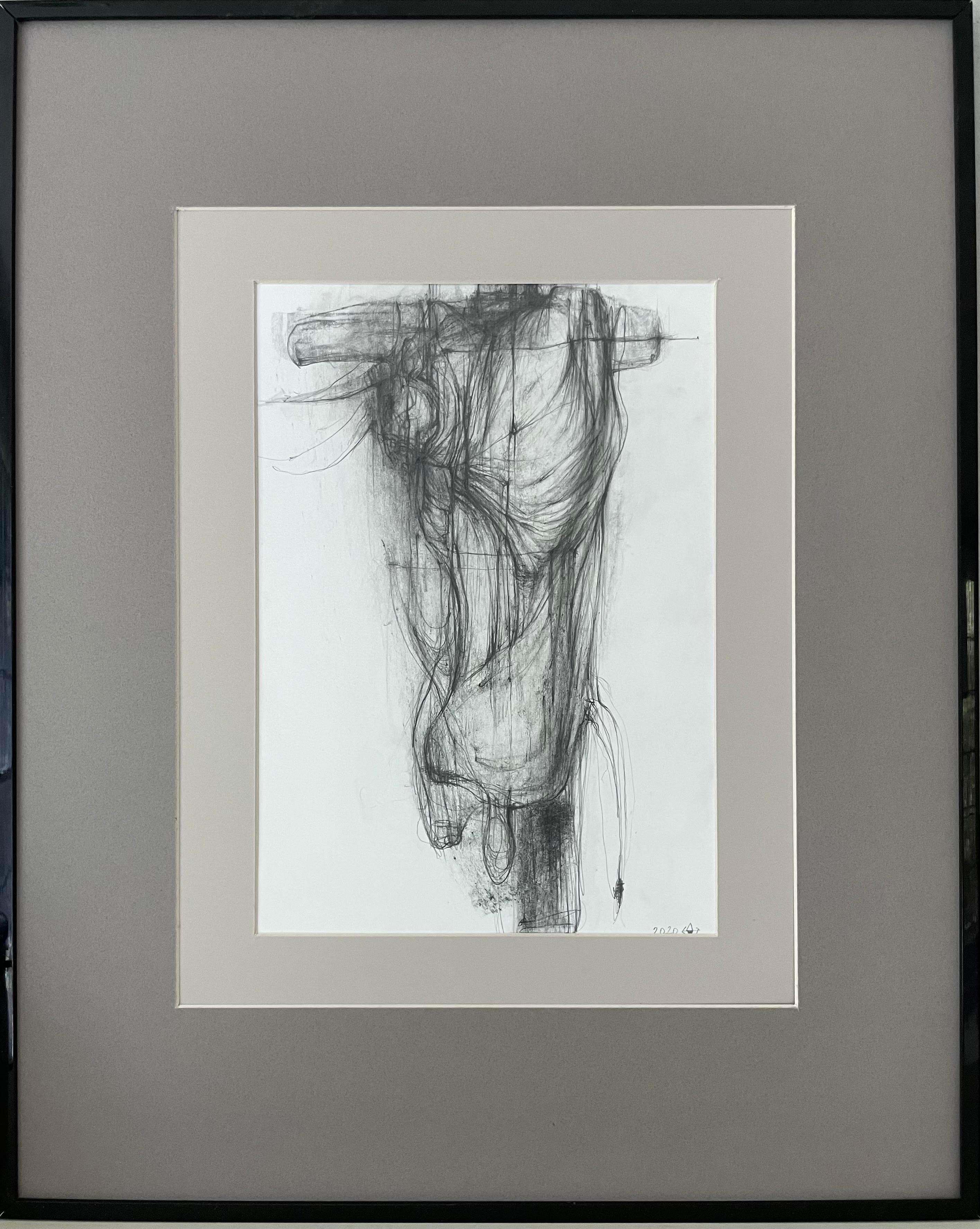Boris Lovet-LorskiUntitled (Standing Female Nude)c. 1930
c. 1930
About the Item
- Creator:Boris Lovet-Lorski (1894 - 1973, American)
- Creation Year:c. 1930
- Dimensions:Height: 9.315 in (23.67 cm)Width: 5.813 in (14.77 cm)
- Medium:
- Movement & Style:
- Period:15th Century and Earlier
- Condition:Good Thin spots verso from previous mounting Soft vertical fold running across image Barely visible on recto.
- Gallery Location:Fairlawn, OH
- Reference Number:
Boris Lovet-Lorski
Boris Lovet-Lorski, sculptor, lithographer and painter, who contributed significantly to the American Art Deco movement, was born in Lithuania in 1894. Trained as an architect at the Royal Academy in Petrograd, throughout his career, Lovet-Lorski was acutely sensitive to volume and structural space. He also incorporated architectural backgrounds in the flattened aesthetic of his Art Deco neoclassicism, hallmarks of his elegant in a distinctly original style. Lovet-Lorski's idealized subject matter and masterful designs quickly won the young sculptor critical acclaim and led to his first one-man show in Boston in 1925, the year he became an American citizen. He was then invited to teach at the Milwaukee Institute of Art & Design, quickly developing a reputation that catapulted him into the New York artistic milieu. He exhibited on a regular basis with the Wildenstein Gallery from 1928 onward. Lovet-Lorski was a quintessentially Art Deco artist. His unique style was an amalgam of Modern, Tribal, Oriental, Archaic and Teutonic influences. His Slavic roots and eclecticism tempered his modernism with lyricism and a sense of mystery. His sculptures, in bronze or Black Belgian Marble, are sleek and gorgeously polished. The work from the 1920s and 1930s often featured exotic, allegorical nudes, stylized horses or busts. Lovet-Lorski was particularly noted for his female nudes with narrow hips, thoracic cages that broaden as they rise from waist to shoulder and wide-spread arms, with hands clasped and held behind or above classically modeled heads that were perched on their torsos like flowers on a stem. Lovet-Lorski's idealized vision coincided perfectly with the mechanization of the era, its gleaming, streamlined airplanes, automobiles and proud skyscrapers, that were the sacramentals of the inter-war period. He regularly worked in sumptuous and precious materials, onyx, jade and rare, fossilized wood essences, such as that taken from a 600-year old, Assyrian lemon tree. He tailored the subjects of his sculptures to suit the nature of his materials. The Belgian black marble of Head of a Woman is a dense and close-grained stone that complements the idealized features of the figure. God Unknown, one of the sculptor's best-known works was carved in pure white Carrara marble. His preferred exteriors were like polished silk,” adding to the serenity and timelessness that his sculptures convey. Lovet-Lorski’s style and the allure of his materials brought him commissions for portraits of high society and celebrated figures. By 1929, he was successful enough to maintain studios in New York, Rome and Paris. Wildenstein Gallery gave him a retrospective exhibit in 1940. His recognition was international and his sculptures were acquired by the permanent collections of over 20 major museums. The sculptor received the French Legion of Honor in 1950. He was a member of the National Academy of Design, the National Sculpture Society, the Society of Independent Artists and the Salons of Paris. His last major work was the Manila War Memorial. He attempted to complete the monument in 1957, but arthritis had crippled him to the point that he could no longer sculpt. He finished his career as a painter and his works continued to enjoy considerable success. Lovet-Lorski's works are held in the collections of the Musée de Luxembourg, Paris; the Bibliothèque Nationale, Paris; the Petit Palais, Paris; the British Museum, London; and many museums and galleries in the United States: the Metropolitan Museum of Art, New York; the Los Angeles Museum of Art; the Seattle Art Museum and the San Francisco Museum of Fine Arts. As an interesting footnote: in his youth, he had considerable success with the feminine sex that was so eloquently extolled in his art.
- ShippingRetrieving quote...Ships From: Fairlawn, OH
- Return PolicyA return for this item may be initiated within 10 days of delivery.
- Preliminary Study for Cretan Dancer BronzeBy Boris Lovet-LorskiLocated in Fairlawn, OHPreliminary Study for Cretan Dancer Bronze Graphite on tracing paper, 1930 Unsigned Note: The bronze sculpture measures 24 1/2 x 33 5/8 inches and is signed and dated 1930 on the base (see image on right). It is currently being offered for sale by Taylor Graham Gallery in New York. (see photo) “The stylizing of the Cretan allegories, used in figures of animals such as horses and bulls, symbolizes the ancient power of the South. These figures reveal a spiritual sensuality as he strives to attain a symbol of the earth and universe endowed with musical values. If man is the center of his idea of life and nature, it is because of the laws that govern the movement of stars and history. The link binding his figures together has, in a sense, a Pythagorean harmony.” Salvatore Quasimodo, Milan, 1967, quoted from Bush, Boris Lover-Lorski: The Language of Time, page 12. Image size: 6 1/2 x 6 1/2 inches Condition: Repaired tear in the lower left corner (see detail photo) Boris Lovet-Lorski Lithuanian/Russian/American 1894-1973 Sculptor, painter, and printmaker, Boris Lovet-Lorski was born in Lithuania in 1894. His mother died when he was age three. His father was affluent and owned real estate. Boris grew up in a privileged environment. He studied architecture and then fine arts at the Imperial Academy of Art in Petrograd, Russia (now Saint Petersburg). Following the revolution in 1917 and its aftermath, Boris immigrated to Boston to live with his brother. In the 1920’s, his stylized, Art Deco inspired sculptures, lithographs, and paintings proved to be popular among the American elite. He exhibited frequently, holding his first solo exhibition in Boston, 1920. In the following years, Boris exhibited in New York at Marie Sterner Gallery, Jacques Seligmann Galleries and Wildenstein and Company. He lived in Paris from 1926 to 1932 where he befriended Joseph Hecht, and was exposed to the works of Pablo Picasso, Ossip Zadkine, Contantin Brancusi and Aristide Maillol. In 1932 he returned to America where he became a citizen later in the decade. Lovet-Lorski exhibited in the United States, South America, Europe and Asia. He was a member of the Society of Independent Artists (New York), the National Academy of Design (New York), and the Lotos Club (New York), as well as several Parisian salons. His work is in the permanent collections of numerous museums including the Musée Luxembourg, Bibliotèque Nationale, and the Petit Palais in France, the British Museum in London, the Metropolitan Museum in New York, the National Gallery in Washington, the Los Angeles County Museum of Art. (A more extensive list of his works in museums follows) He is considered one of the most successful and recognized sculptors of his generation. His creative influence can be seen in many of his contemporary artists. He died in Los Angeles in 1973. Regarding his iconic Art Deco sculptures of Cretan Dancers: “The stylizing of the Cretan allegories, used in figures of animals such as horses and bulls, symbolizes the ancient power of the South. These figures reveal a spiritual sensuality as he strives to attain a symbol of the earth and universe endowed with musical values. If man is the center of his idea of life and nature, it is because of the laws that govern the movement of stars and history. The link binding his figures together has, in a sense, a Pythagorean harmony.” Salvatore Quasimodo, Milan, 1967, quoted from Bush, Boris Lover-Lorski: The Language of Time, page 12. Lovet-Lorski created sculptures of the following major figures I.J. Paderewski, Prime Minister of Poland Arturo Toscanini, Italian Conductor Lilian Gish, Actress President Franklin D. Roosevelt Mrs. M. C. Niarchos, wife of Stavros Niarchos President Abraham Lincoln James Forrestal, Secretary of...Category
1930s Art Deco Nude Drawings and Watercolors
MaterialsGraphite
- Untitled (Two Standing Nudes, one seated nude)By Boris Lovet-LorskiLocated in Fairlawn, OHUntitled (Two Standing Nudes, one seated nude) Graphite on wove paper, heightened with color, c. 1930 Unsigned From a sketchbook created while the artist was working in Paris Condition: Very good Provenance: Estate of the Artist Dawson's Auction, Morris Plains, NY, 2001 Boris Lovet-Lorski Lithuanian/Russian/American 1894-1973 Sculptor, painter, and printmaker, Boris Lovet-Lorski was born in Lithuania in 1894. His mother died when he was age three. His father was affluent and owned real estate. Boris grew up in a privileged environment. He studied architecture and then fine arts at the Imperial Academy of Art in Petrograd, Russia (now Saint Petersburg). Following the revolution in 1917 and its aftermath, Boris immigrated to Boston to live with his brother. In the 1920’s, his stylized, Art Deco inspired sculptures, lithographs, and paintings proved to be popular among the American elite. He exhibited frequently, holding his first solo exhibition in Boston, 1920. In the following years, Boris exhibited in New York at Marie Sterner Gallery, Jacques Seligmann Galleries and Wildenstein and Company. He lived in Paris from 1926 to 1932 where he befriended Joseph Hecht, and was exposed to the works of Pablo Picasso, Ossip Zadkine, Contantin Brancusi and Aristide Maillol. In 1932 he returned to America where he became a citizen later in the decade. Lovet-Lorski exhibited in the United States, South America, Europe and Asia. He was a member of the Society of Independent Artists (New York), the National Academy of Design (New York), and the Lotos Club (New York), as well as several Parisian salons. His work is in the permanent collections of numerous museums including the Musée Luxembourg, Bibliotèque Nationale, and the Petit Palais in France, the British Museum in London, the Metropolitan Museum in New York, the National Gallery in Washington, the Los Angeles County Museum of Art. (A more extensive list of his works in museums follows) He is considered one of the most successful and recognized sculptors of his generation. His creative influence can be seen in many of his contemporary artists. He died in Los Angeles in 1973. Regarding his iconic Art Deco sculptures of Cretan Dancers: “The stylizing of the Cretan allegories, used in figures of animals such as horses and bulls, symbolizes the ancient power of the South. These figures reveal a spiritual sensuality as he strives to attain a symbol of the earth and universe endowed with musical values. If man is the center of his idea of life and nature, it is because of the laws that govern the movement of stars and history. The link binding his figures together has, in a sense, a Pythagorean harmony.” Salvatore Quasimodo, Milan, 1967, quoted from Bush, Boris Lover-Lorski: The Language of Time, page 12. Lovet-Lorski created sculptures of the following major figures I.J. Paderewski, Prime Minister of Poland Arturo Toscanini, Italian Conductor Lilian Gish, Actress President Franklin D. Roosevelt Mrs. M. C. Niarchos, wife of Stavros Niarchos President Abraham Lincoln James Forrestal, Secretary of the Navy, First Secretary of Defense Pope Pius XII Dr. Albert Einstein, theoretical physicist President Dwight D. Eisenhower Albert Schweitzer, theologian, organist, writer, humanitarian, philosopher, and physician General Charles De Gaulle, President of the Fourth and Fifth Republic, France John Foster Dulles, Secretary of State, 1953-1959 President John F. Kennedy Works by Lover Lorski are in the following public collections: Albright-Knox Art Gallery, Buffalo Art Institute of Chicago Bibliotheque Nationale, Paris Brandeis University, Waltham, MA British Museum, London Boston University Brooklyn Museum California Palace of the Legion of Honor, Sam Francisco...Category
1930s Art Deco Nude Drawings and Watercolors
MaterialsGraphite
- Standing Male NudeBy Frank DuveneckLocated in Fairlawn, OHStanding Male Nude Graphite on wove paper, c. 1890's Unsigned Sheet size: 9 5/16 x 6 inches Provenance: Rookwood Pottery Factory Collection, Cincinnati Ira Spanierman, New York (labe...Category
1890s Nude Drawings and Watercolors
MaterialsGraphite
- Nude Seated in ChairBy William H. BaileyLocated in Fairlawn, OHNude Seated in Chair Graphite on paper, 1976 Signed and dated lower right (see photo) Exhibited: Dart Gallery, Chicago, 1976 (see photo of label) Condition: Excellent Sheet size: 14 7/8 x 11 1/8 inches Provenance: Dart Gallery, Chicago, 1976 William H. Bailey (American, b. 1930) Born in Council Bluffs, Iowa, William Bailey became a painter in styles ranging from abstraction to super-real. He earned his B.F.A. and M.F.A. at Yale University and studied with Josef Albers and also had an Alice Kimball English traveling scholarship. From 1962 to 1969, he taught at Indiana University, and from 1969, was a professor of art at Yale University. He lives and works in Branford, CT and is a member of the National Academy of Design, elected an Associate in 1983, an Academician in 1994. Recent one-person exhibitions include Robert Schoelkopf Gallery; Andre Emmerich Gallery; Robert Miller Gallery; Galleria il Gabbiana, Rome; and Galerie Claude Bernard, Paris. Selected group exhibitions include Realism Now, Vassar College Art Museum; 22 Realists, and 7 Realists, both at the Yale University Art Gallery; Decade in Review, Whitney Museum of American Art; and Contemporary American Realism Since 1960,at the Pennsylvania Academy. His work is included in the collections of the Museum of Modern Art; Museum of Fine Arts, Boston; Des Moines Art Center; Art Institute of Chicago; Arkansas Art Center; Hirshhorn Museum; Pennsylvania Academy; St. Louis Museum of Art; Whitney Museum of American Art; and Yale University Art Gallery. Publications on Mr. Bailey include "William Bailey", by Mark Strand...Category
1970s American Realist Nude Drawings and Watercolors
MaterialsGraphite
- Untitled (Standing Woman)By Léopold SurvageLocated in Fairlawn, OHLeopold Survage (1879-1968) Untitled (Woman Standing) Graphite on paper, 1933 Signed in pencil by the artist: Survage Signed with the estate stamp lower right Signed in pencil "LS" f...Category
1930s Cubist Nude Drawings and Watercolors
MaterialsGraphite
- Side View Seated Female NudeBy Frank DuveneckLocated in Fairlawn, OHSide View Seated Female Nude Graphite on paper, c. 1890's Unsigned Provenance: Rookwood Pottery Factory Collection, Cincinnati Spanierman Gallery, New York (label) Drawings from the sketchbook are in the collections of the Munson Williams Proctor Institute in Utica, New York and the Picker Art Gallery, Colgate University, Hamilton, New York. Condition: Excellent Sheet size: 9 1/4 x 6 1/4 inches Frame size: 16 x 12 1/2 inches Frank Duveneck (1848-1919) Born in Covington, Kentucky, Frank Duveneck had the birth name of Frank Decker. He became a well-trained academic painter whose work ranged from single figures in interiors to plein air canvases of figures in landscape and often included the depiction of low-life persons. His styles included Realism, Social Realism, and Impressionism, and his work was ever influenced by the dark tones and vigorous brush-strokes of the Munich style, which he learned at the Munich Academy in the 1870s. Art historian Matthew Baigell described Duveneck's mature style as having "loose highlights brushed over ruggedly blocked-out forms emerging from a richly suggestive chiaroscuro." He apprenticed to a church decorator, Wilhelm Lamprecht, in Cincinnati, and worked in Catholic Churches in Covington, Cincinnati, Latrobe, Pennsylvania and Quebec, Canada. At age 22, entered the Royal Academy of Munich where he intended to further his interest in church decoration but instead veered to fine-art painting on canvas. One of his most influential teachers was realist Wilhelm von Diez, and Duveneck, also impressed by the realism of French painter Gustave Courbet, became known for adopting this revolutionary approach with rich brushwork. In Munich, Duveneck shared a studio with William Merritt Chase. Returning to Cincinnati, he painted portraits and decorated churches and also taught art classes. At first he did not gain much attention, but an exhibition in Boston in 1875 gained him good attention. In 1875, he went back to Europe and opened an art school in Munich and also in Poling in Bavaria, and many Americans who became known as "Duveneck's Boys," studied with him. Several years later, he opened his school in Italy where he spent the winters in Florence and the summers in Venice. In 1879, he and his followers went to Venice where he began etching and briefly shared a studio with James Whistler in order to learn from him. He also did sculpture. During this period, his painting changed drastically from dark interiors with heavy, impasto paint to outdoor, plein air painting in much lighter colors giving the appearance of sunlight. Among his students was the future Impressionist painter John Henry Twachtmann, and also Elizabeth Boott, whom he married in 1886 and who died two years later. In 1888, he returned to Cincinnati where from 1900 he taught at the Cincinnati Art Academy. He spent the summers in Gloucester, Massachusetts painting...Category
1890s American Impressionist Nude Drawings and Watercolors
MaterialsGraphite
- 'Vestal Virgin', Danish Modernism, Art Deco Figural, Mythological, Neo-classicalLocated in Santa Cruz, CASigned lower left, 'F. Sedivy' for Franz Sedivy II (Danish, 1888-1973) and dated 1959. A dramatic figural painting of a young woman, shown naked and holding aloft an earthenware oil...Category
1950s Art Deco Nude Drawings and Watercolors
MaterialsPaper, Watercolor, Gouache, Graphite
- The Bull III - expressive line drawingBy Dmitrii DrugakovLocated in Fort Lee, NJThe Bull III - expressive line drawing on 140lb paper. The work is size 12x8 inches framed (black) with a styrene face on a double mat board in grey-beige or white-beige color with s...Category
2010s Contemporary Animal Drawings and Watercolors
MaterialsPaper, Graphite
- The Bull V - expressive line drawingBy Dmitrii DrugakovLocated in Fort Lee, NJThe Bull V - expressive line drawing on 140lb paper. The work is size 12x8 inches framed (black) with a styrene face on a double mat board in grey-beige or white-beige color with siz...Category
2010s Contemporary Animal Drawings and Watercolors
MaterialsPaper, Graphite
- The Bull II- expressive line drawingBy Dmitrii DrugakovLocated in Fort Lee, NJThe Bull II - expressive line drawing on 140lb paper. Part of the triptych. His artistic style is rather difficult to describe, it can be named as "expressive romanticism". Usually,...Category
2010s Contemporary Animal Drawings and Watercolors
MaterialsPaper, Graphite
- The Bull III - expressive line drawingBy Dmitrii DrugakovLocated in Fort Lee, NJThe Bull III - expressive line drawing on 140lb paper. Part of the triptych. His artistic style is rather difficult to describe, it can be named as "expressive romanticism". Usually...Category
2010s Contemporary Animal Drawings and Watercolors
MaterialsPaper, Graphite
- Bul IlI - expressive line drawingBy Dmitrii DrugakovLocated in Fort Lee, NJBull III- expressive line drawing on 140lb paper. Part of the triptych. The work size is 12x8 inches framed (black) with a styrene face on a double mat board in grey-beige or white-b...Category
2010s Contemporary Animal Paintings
MaterialsPaper, Graphite
